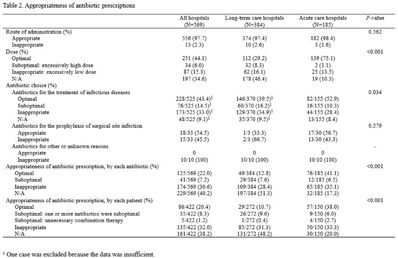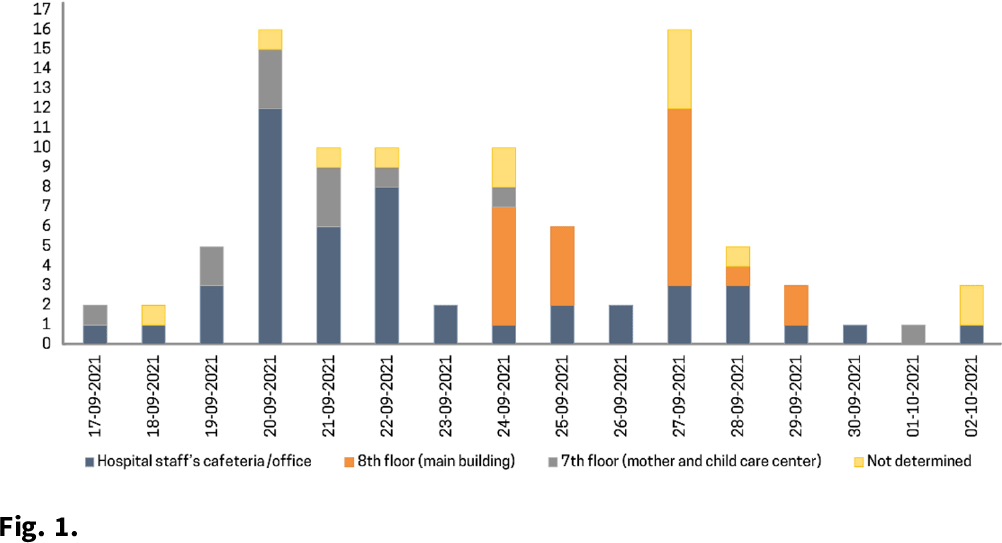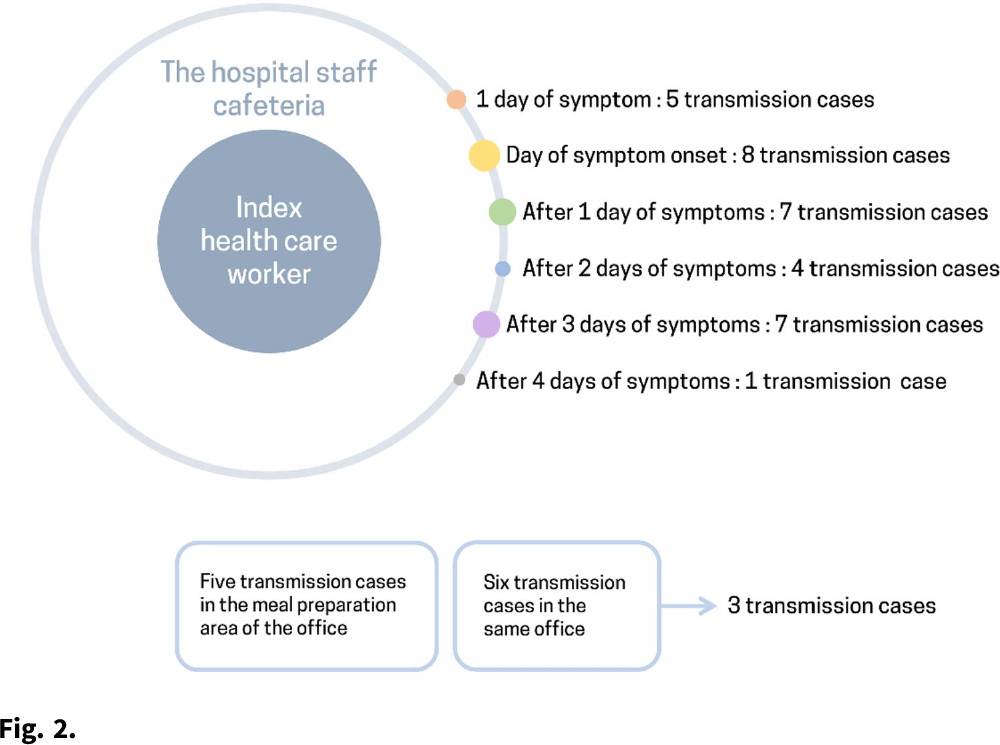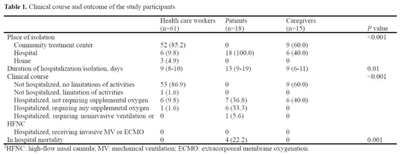52 results
Clinical impact of COVID-19 in patients with carbapenem-resistant Acinetobacter baumannii bacteraemia
-
- Journal:
- Epidemiology & Infection / Volume 151 / 2023
- Published online by Cambridge University Press:
- 10 October 2023, e180
-
- Article
-
- You have access
- Open access
- HTML
- Export citation
Is spiritual well-being related to survival time of inpatients with advanced cancer? An East Asian cohort study
-
- Journal:
- Palliative & Supportive Care / Volume 21 / Issue 3 / June 2023
- Published online by Cambridge University Press:
- 27 June 2022, pp. 483-491
-
- Article
- Export citation
Prescriptions patterns and appropriateness of usage of antibiotics in small and medium- sized hospitals in Korea
-
- Journal:
- Antimicrobial Stewardship & Healthcare Epidemiology / Volume 2 / Issue S1 / July 2022
- Published online by Cambridge University Press:
- 16 May 2022, p. s19
-
- Article
-
- You have access
- Open access
- Export citation
A SARS-CoV-2 outbreak due to vaccine breakthrough in an acute-care hospital
-
- Journal:
- Antimicrobial Stewardship & Healthcare Epidemiology / Volume 2 / Issue S1 / July 2022
- Published online by Cambridge University Press:
- 16 May 2022, p. s83
-
- Article
-
- You have access
- Open access
- Export citation
Outbreak of COVID-19 among children and young adults in a cancer centre daycare unit
-
- Journal:
- Epidemiology & Infection / Volume 150 / 2022
- Published online by Cambridge University Press:
- 21 February 2022, e40
-
- Article
-
- You have access
- Open access
- HTML
- Export citation
Comparison of Objective Prognostic Score and Palliative Prognostic Score performance in inpatients with advanced cancer in Japan and Korea
-
- Journal:
- Palliative & Supportive Care / Volume 20 / Issue 5 / October 2022
- Published online by Cambridge University Press:
- 05 October 2021, pp. 662-670
-
- Article
- Export citation
Multi-Energy X-Ray Computed Tomography for Source Rock Characterization
-
- Journal:
- Microscopy and Microanalysis / Volume 27 / Issue S1 / August 2021
- Published online by Cambridge University Press:
- 30 July 2021, pp. 1030-1031
- Print publication:
- August 2021
-
- Article
-
- You have access
- Export citation
“The surprise questions” using variable time frames in hospitalized patients with advanced cancer
-
- Journal:
- Palliative & Supportive Care / Volume 20 / Issue 2 / April 2022
- Published online by Cambridge University Press:
- 17 June 2021, pp. 221-225
-
- Article
- Export citation
Association between levels of thiamine intake, diabetes, cardiovascular diseases and depression in Korea: a national cross-sectional study
-
- Journal:
- Journal of Nutritional Science / Volume 10 / 2021
- Published online by Cambridge University Press:
- 27 April 2021, e31
-
- Article
-
- You have access
- Open access
- HTML
- Export citation
Adding versus Arguing: Narratology and Taxonomy
-
- Journal:
- PMLA / Publications of the Modern Language Association of America / Volume 135 / Issue 5 / October 2020
- Published online by Cambridge University Press:
- 18 January 2021, pp. 982-988
- Print publication:
- October 2020
-
- Article
- Export citation
A molecular dynamics study on the effect of modified silica surface on water vapor diffusion in the silica–polyurethane nanocomposite membrane
-
- Journal:
- MRS Communications / Volume 10 / Issue 3 / September 2020
- Published online by Cambridge University Press:
- 03 July 2020, pp. 492-499
- Print publication:
- September 2020
-
- Article
- Export citation
A Pilot Study of Surge Capacity in the Metropolitan Area of South Korea
-
- Journal:
- Prehospital and Disaster Medicine / Volume 34 / Issue s1 / May 2019
- Published online by Cambridge University Press:
- 06 May 2019, pp. s158-s159
- Print publication:
- May 2019
-
- Article
-
- You have access
- Export citation
Comparison of Traumatic Brain Injury Patients by Age Group in Emergency Department
-
- Journal:
- Prehospital and Disaster Medicine / Volume 34 / Issue s1 / May 2019
- Published online by Cambridge University Press:
- 06 May 2019, p. s110
- Print publication:
- May 2019
-
- Article
-
- You have access
- Export citation
Figuring Korean Futures: Children's Literature in Modern Korea. By Dafna Zur. Stanford, Calif.: Stanford University Press, 2017. xii, 286 pp. ISBN: 9781503601680 (cloth, also available as e-book).
-
- Journal:
- The Journal of Asian Studies / Volume 78 / Issue 1 / February 2019
- Published online by Cambridge University Press:
- 12 March 2019, pp. 211-212
- Print publication:
- February 2019
-
- Article
-
- You have access
- HTML
- Export citation
Altered functional connectivity in the fear network of firefighters with repeated traumatic stress
-
- Journal:
- The British Journal of Psychiatry / Volume 214 / Issue 6 / June 2019
- Published online by Cambridge University Press:
- 27 November 2018, pp. 347-353
- Print publication:
- June 2019
-
- Article
-
- You have access
- HTML
- Export citation
2 - Questions of Scale: Narrative Theory and Literary History
- from Part I - Foundations
-
-
- Book:
- The Cambridge Companion to Narrative Theory
- Published online:
- 19 October 2018
- Print publication:
- 01 November 2018, pp 29-45
-
- Chapter
- Export citation
Is spirituality related to survival in advanced cancer inpatients in Korea?
-
- Journal:
- Palliative & Supportive Care / Volume 16 / Issue 6 / December 2018
- Published online by Cambridge University Press:
- 21 December 2017, pp. 669-676
-
- Article
- Export citation
Lifting the Veil on Ultra Metal-Poor Stars in the Outermost Halo
-
- Journal:
- Proceedings of the International Astronomical Union / Volume 13 / Issue S334 / July 2017
- Published online by Cambridge University Press:
- 02 August 2018, pp. 389-390
- Print publication:
- July 2017
-
- Article
-
- You have access
- Export citation
Assembly of the Galactic Halo System Based on Carbon-Enhanced Metal-Poor Stars
-
- Journal:
- Proceedings of the International Astronomical Union / Volume 13 / Issue S334 / July 2017
- Published online by Cambridge University Press:
- 02 August 2018, pp. 327-328
- Print publication:
- July 2017
-
- Article
-
- You have access
- Export citation
Middle Holocene environmental change in central Korea and its linkage to summer and winter monsoon changes
-
- Journal:
- Quaternary Research / Volume 84 / Issue 1 / July 2015
- Published online by Cambridge University Press:
- 20 January 2017, pp. 37-45
-
- Article
- Export citation






